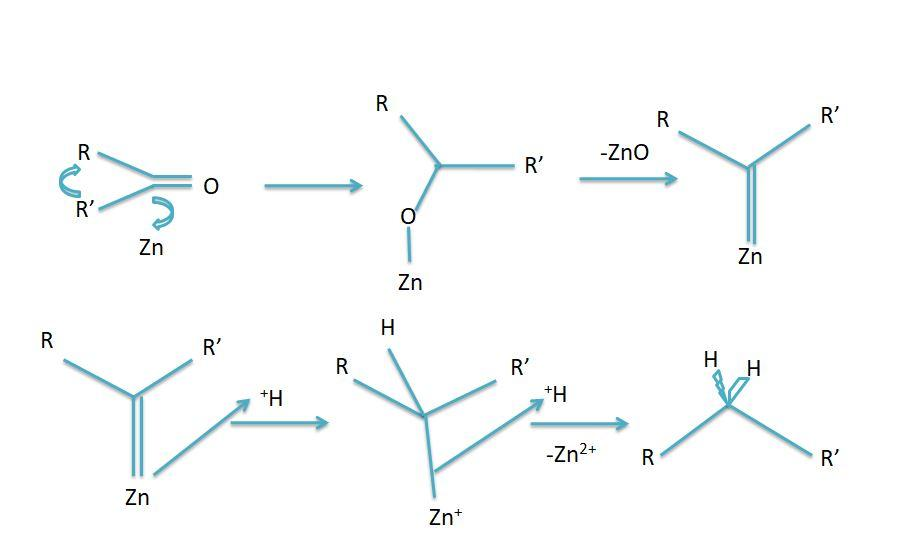
In the reaction ${C_6}{H_5}COC{H_3}\xrightarrow[{Zn - Hg/conc.HCl}]{{[H]}}X$. X is:
A.Toluene
B.Methylbenzene
C.Benzyl Alcohol
D.Ethylbenzene
Answer
573.6k+ views
Hint: The reduction of the aldehydes and ketones to the hydrocarbons in the presence of the zinc amalgam (Zn/ Hg) and concentrated HCl is known as Clemmensen Reduction. This reaction is of main use in the reduction process of the aldehydes and ketones to get the higher order hydrocarbons.
Complete step by step answer:
The deoxygenation of the corresponding aldehydes and ketones takes place to produce the hydrocarbons, i.e. the compounds consisting mainly of carbon and hydrogen. The catalyst used in the process is the Zinc Amalgam. The compounds of mercury with the metals are known as amalgams, they are given by the general formula M-Hg where M is the metal.
Every reaction follows a particular reaction mechanism the general mechanism for the Clemmensen reduction is as follows:

However the mechanism is not completely understood yet but two mechanisms were put forward to know the probable mechanism of the reaction these are:
-Carbenoid Mechanism: This mechanism states that the reduction process takes place on the surface of the zinc catalyst. No alcohol as an intermediate is formed in the reaction.
-Carbanionic mechanism: This mechanism states that zinc metal directly attacks the protonated carbon.

Thus in the above reaction Methylbenzene will be formed as follows:
Another complementary reaction used for such purpose to obtain the hydrocarbon is the Wolff-Kishner Reduction, in which the reaction condition is strongly basic whereas acidic conditions are used in the Clemmensen reaction; the substrate must be stable to acid to undergo the Clemmensen reaction.
So the option B is the correct answer.
Note:
The Clemmensen reduction reaction is more effective for the cyclic ketones or aliphatic compounds and for the zinc metal i.e. for the reduction of the aryl-alkyl ketones which are actively formed during the Friedel-Crafts acylation reaction.
Complete step by step answer:
The deoxygenation of the corresponding aldehydes and ketones takes place to produce the hydrocarbons, i.e. the compounds consisting mainly of carbon and hydrogen. The catalyst used in the process is the Zinc Amalgam. The compounds of mercury with the metals are known as amalgams, they are given by the general formula M-Hg where M is the metal.
Every reaction follows a particular reaction mechanism the general mechanism for the Clemmensen reduction is as follows:

However the mechanism is not completely understood yet but two mechanisms were put forward to know the probable mechanism of the reaction these are:
-Carbenoid Mechanism: This mechanism states that the reduction process takes place on the surface of the zinc catalyst. No alcohol as an intermediate is formed in the reaction.
-Carbanionic mechanism: This mechanism states that zinc metal directly attacks the protonated carbon.

Thus in the above reaction Methylbenzene will be formed as follows:
Another complementary reaction used for such purpose to obtain the hydrocarbon is the Wolff-Kishner Reduction, in which the reaction condition is strongly basic whereas acidic conditions are used in the Clemmensen reaction; the substrate must be stable to acid to undergo the Clemmensen reaction.
So the option B is the correct answer.
Note:
The Clemmensen reduction reaction is more effective for the cyclic ketones or aliphatic compounds and for the zinc metal i.e. for the reduction of the aryl-alkyl ketones which are actively formed during the Friedel-Crafts acylation reaction.
Recently Updated Pages
A man running at a speed 5 ms is viewed in the side class 12 physics CBSE

State and explain Hardy Weinbergs Principle class 12 biology CBSE

Which of the following statements is wrong a Amnion class 12 biology CBSE

Two Planoconcave lenses 1 and 2 of glass of refractive class 12 physics CBSE

The compound 2 methyl 2 butene on reaction with NaIO4 class 12 chemistry CBSE

Bacterial cell wall is made up of A Cellulose B Hemicellulose class 12 biology CBSE

Trending doubts
What are the major means of transport Explain each class 12 social science CBSE

Which are the Top 10 Largest Countries of the World?

Draw a labelled sketch of the human eye class 12 physics CBSE

Explain sex determination in humans with line diag class 12 biology CBSE

The pH of the pancreatic juice is A 64 B 86 C 120 D class 12 biology CBSE

Give 10 examples of unisexual and bisexual flowers




